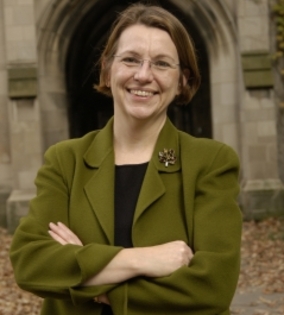Memory & Glorious Life: A Q&A With Dr. Kristine A. Culp
December 08, 2016 • By Kristine A. Culp
The word “glory” is rife with associations—most of them theological, and most of them pertaining specifically to God. However, Dr. Kristine Culp, professor of theology in the Divinity School and dean of the Disciples Divinity House, is interested in expanding the ways in which we think about the concept of glory, and discussing the ways that glory has to do with our own human existence. Here, she discusses how her research for The Enhancing Life Project intersects with the course she recently taught in the College.
Tell us a little bit about your research for The Enhancing Life Project.
I’m looking at glory—my project is Glorious Life?—and it’s an interesting category that, theologically, is first engaged in reference to the glory of God. There’s a lot more ambiguity about whether glory should rightly apply to human creatures and creation, which is my focus. I’m thinking about glory as the aliveness of life, and considering how “aliveness” appears in lilies (in the Sermon on the Mount) and in Rothko’s paintings—that is, in given and created things—and in human creatures. So, it’s less a method of directly engaging with what enhances and endangers life or of how to measure enhancement or endangerment, and more a way of exploring and understanding what life is like in its full integrity—in its glory. In that sense it’s political in an indirect way, it’s political in the sense of asking the question: where does the aliveness of life appear? How do we know that, and how do we recognize that? Can we ensure spaces where the aliveness of life can appear?
What was your Enhancing Life studies course about?
Last Spring in the College, I taught “The Autobiographies of Dorothy Day and Malcolm X,” and in that class we looked how two consequential individuals narrated the course of their lives and the emergence of the movements associated with them. We were effectively examining what the aliveness of life looks like. Both autobiographies are attentive to the sensory richness of life in relation to memory and anticipation, and that attention is interrelated with their search for selves, human solidarity, and the divine, and with their transformative lives and work. One segment of the course considered Augustine’s Confessions and Frederick Douglass’s 1845 Narrative, which further attuned these considerations of memory and self-narration.
Who were your students, and what did you have them do?
It was a great group of College students, with a great cross-section of students—the course originated with the Fundamentals: Issues and Texts Program and was cross-listed with Religious Studies, Gender and Sexuality Studies, and Comparative Race and Ethnic Studies. The course let the students think about how their own lives have unfolded, and about what questions are good questions to ask to think about the power of others’ lives and their own lives. Since it was a Fundamentals course, we read those two autobiographies very closely—we actually read them twice together.
Were there any surprises during the course, either for you or for your students?
The students had the option, for their final paper, to write their own autobiography. It was profoundly interesting and gratifying to have these amazing students offer narrations of their own lives, crafted in relation to Malcolm X and Dorothy Day, but fully their own. The students really poured their intellects and souls into the work for the course.
Are there any changes for the next time you teach the course, or is there anything that you’ll be sure to retain?
The students created the second half of the course by identifying their own angles of inquiry for exploring themes where the two texts intersected. So, the course will naturally change the next time around, and that’s a wonderful part of the course.
How did this course on autobiography inform your Enhancing Life Project research?
At the beginning of the course on autobiography, I was only beginning to consider how memory might enter into the project. The course was ultimately the reason that the work on Rothko took the turn toward Augustine and memory that it did, which then led me this summer to an exploration of brain science. So, a lot of that development happened because I was teaching the course in relation to looking at Rothko, which was a very happy coincidence, and which will be an important part of the bigger project.
For more of Dr. Culp’s work, see:
Stopping by Rothko: Art, Memory, and Brain Science